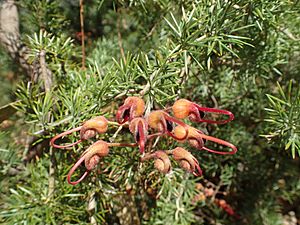Mount Lesueuer grevillea facts for kids
Quick facts for kids Mt Lesueur grevillea |
|
|---|---|
 |
|
| Grevillea batrachioides in Kings Park | |
| Conservation status | |
| Scientific classification | |
| Genus: |
Grevillea
|
| Species: |
batrachioides
|
The Mount Lesueur grevillea (scientific name: Grevillea batrachioides) is a special type of shrub. It only grows in a small part of Western Australia, near the west coast. This plant is very rare. It is a threatened species and is listed as critically endangered. This means there are very few of these plants left in the wild.
Contents
What Does It Look Like?
The Mount Lesueur grevillea is a shrub that usually grows between 0.5 and 2 meters (about 1.5 to 6.5 feet) tall. Its branches have a slightly blue-green, waxy coating.
Leaves and Flowers
Its leaves are long and narrow, like feathers. They are about 10 to 40 millimeters (0.4 to 1.6 inches) long. The edges of the leaves are rolled under.
This plant has pretty pink flowers. They grow in a cluster at the end of the branches. You can usually see these flowers from October to December. After the flowers, the plant produces small, brown, hairy fruits. These fruits are shaped like an oval and have ribs.
How It Got Its Name
The Mount Lesueur grevillea was first officially described in 1986. A scientist named D.J. McGillivray wrote about it. He used notes from an earlier description by Ferdinand von Mueller.
Meaning of the Name
The plant's scientific name, batrachioides, has a cool meaning. It comes from two old Greek words. Batrachos means "frog." The ending oides means "likeness" or "similar to." This name was chosen because the plant looks a bit like some types of water buttercups. These buttercups are in a group called Batrachium, which sounds like "frog."
Why It Needs Our Help
The Mount Lesueur grevillea was first called a rare plant in 1992. Later, in 2000, it was listed as Critically Endangered. This is the highest level of threat for a species.
How Many Are Left?
In 2002, scientists found only one group of these plants. There were only 45 adult plants and 13 younger ones. That's a very small number!
Main Dangers
This special plant faces a few big dangers.
- Bushfires: Fires can destroy the plants.
- Diseases: Plant diseases can also harm them.
- People's Activities: Things like walking or driving in the area can accidentally damage the plants.
Protecting these plants is very important. It helps keep our natural world healthy.


